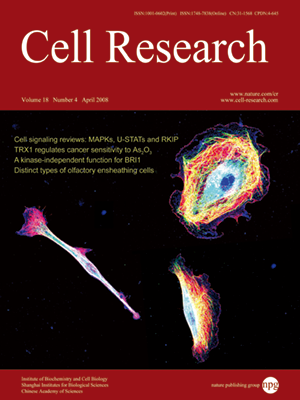
Volume 18, No 4, Apr 2008
ISSN: 1001-0602
EISSN: 1748-7838 2018
impact factor 17.848*
(Clarivate Analytics, 2019)
Volume 18 Issue 4, April 2008: 436-442
REVIEWS
The roles of MAPKs in disease
Michael C Lawrence, Arif Jivan, Chunli Shao, Lingling Duan, Daryl Goad, Elma Zaganjor, Jihan Osborne, Kathleen McGlynn, Steve Stippec, Svetlana Earnest, Wei Chen and Melanie H Cobb
Department of Pharmacology, University of Texas Southwestern Medical Center at Dallas, 6001 Forest Park Road, Dallas, TX 75390-9041, USA
Correspondence: Melanie H Cobb(Melanie.Cobb@UTSouthwestern.edu)
MAP kinases transduce signals that are involved in a multitude of cellular pathways and functions in response to a variety of ligands and cell stimuli. Aberrant or inappropriate functions of MAPKs have now been identified in diseases ranging from cancer to inflammatory disease to obesity and diabetes. In many cell types, the MAPKs ERK1/2 are linked to cell proliferation. ERK1/2 are thought to play a role in some cancers, because mutations in Ras and B-Raf, which can activate the ERK1/2 cascade, are found in many human tumors. Abnormal ERK1/2 signaling has also been found in polycystic kidney disease, and serious developmental disorders such as cardio-facio-cutaneous syndrome arise from mutations in components of the ERK1/2 cascade. ERK1/2 are essential in well-differentiated cells and have been linked to long-term potentiation in neurons and in maintenance of epithelial polarity. Additionally, ERK1/2 are important for insulin gene transcription in pancreatic beta cells, which produce insulin in response to increases in circulating glucose to permit efficient glucose utilization and storage in the organism. Nutrients and hormones that induce or repress insulin secretion activate and/or inhibit ERK1/2 in a manner that reflects the secretory demand on beta cells. Disturbances in this and other regulatory pathways may result in the contribution of ERK1/2 to the etiology of certain human disorders.
Cell Research (2008) 18:436-442. doi: 10.1038/cr.2008.37; published online 18 March 2008
FULL TEXT | PDF
Browse 1825


